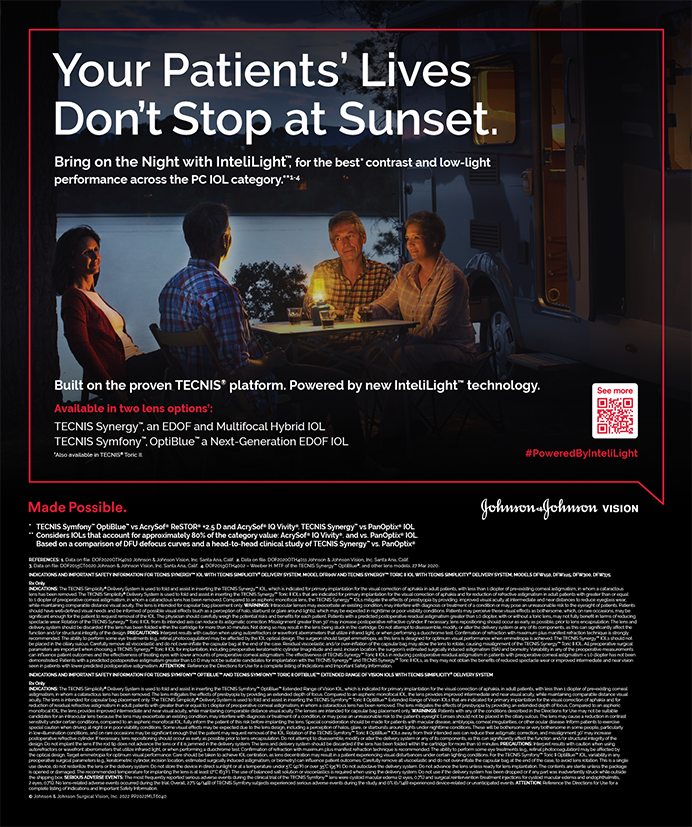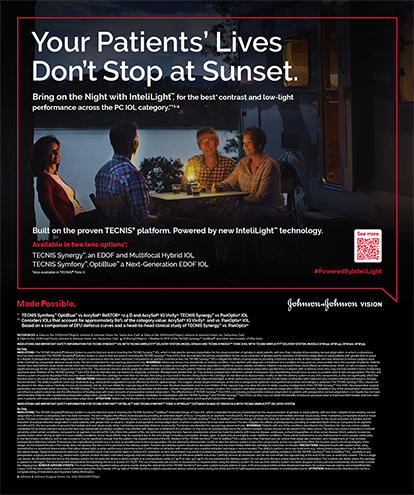Excimer laser surgery corrects refractive defects by flattening or steepening the central anterior corneal curvature. Despite the technological evolution of the last 20 years, measuring the true postoperative power of the cornea remains a challenge. It is therefore difficult to objectively assess the amount of surgically induced refractive change and to obtain a dioptric value to be entered into IOL power formulas after PRK or LASIK. Corneal ray tracing may offer a solution.
THE PROBLEM OF THE KERATOMETRIC INDEX
Why is it so challenging to measure corneal dioptric power after refractive surgery? The main reason is that all diagnostic instruments measure the curvature and not the dioptric power of the cornea. They convert the calculated corneal radius into corneal diopters using the keratometric index of refraction. This value (most often 1.3375) does not correspond to the refractive index of any component of the eye. It is a fictitious number that was introduced to derive the dioptric power of the whole cornea (anterior and posterior surfaces) from just the anterior corneal curvature.
The equation to calculate the power of the cornea from its radius is as follows: P = (n - 1)/r. P is the corneal power in diopters, n is the keratometric index, and r is the radius in meters. This equation is used by both (auto)keratometers for keratometry (K) readings as well as by corneal topographers and tomographers for simulated keratometry (SimK) readings. All ophthalmologists are familiar with K and SimK values, and they have proven reliable in unoperated eyes when entered into IOL power formulas.
This conversion from curvature to power values is theoretically incorrect, however, because the keratometric index of refraction is a fabrication. A clear demonstration involves measurements of the dioptric power of the posterior corneal surface. Several studies using Scheimpflug cameras such as the Pentacam Comprehensive Eye Scanner (Oculus Optikgeräte GmbH, Wetzlar, Germany) or other technologies such as optical coherence tomography have reported a mean value for the posterior corneal curvature of about 6.4 mm.1-4 This corresponds to a mean dioptric value of -6.20 D, as calculated using the refractive index of the cornea (n = 1.376) and aqueous humor (n = 1.336). Conversely, when our group previously derived the posterior corneal power from standard corneal topography (by subtracting the SimK from the anterior corneal power), we obtained a mean value of -4.98 D.5 This discrepancy reflects the theoretical invalidity of the commonly used keratometric index of refraction.
CONSEQUENCES OF INCORRECT MEASUREMENTS OF CORNEAL POWER FOR IOL POWER CALCULATIONS
The intrinsic limits of calculating corneal power by means of the keratometric index of refraction have been highlighted by IOL power calculations after myopic excimer laser surgery. In the past, hyperopic surprises were common.6,7 Errors in IOL power calculations were in part caused by an overestimation of the corneal power. Other sources of error related to the calculation of the effective lens position and the location of radial measurements with respect to the optical zone. Corneal power was overestimated, because the keratometric index loses its reliability once laser ablation changes the relationship between the curvature of the anterior and posterior corneal surfaces.6
CORNEAL RAY TRACING TO CALCULATE IOL POWER AFTER REFRACTIVE SURGERY
In the past 15 years, more than 30 methods have been described for calculating corneal power after excimer laser surgery and avoiding refractive surprises after cataract surgery. 8 Although some are quite accurate,9 calculating modified corneal powers and selecting the best ones are time consuming and may lead to mistakes. Given that the prime cause of inaccurately calculated corneal power has been identified (ie, the keratometric index), the most logical solution is to eliminate it. Avoiding the keratometric index will also permit surgeons to properly compare preoperative and postoperative corneal power, assess the predictability of excimer laser treatments, and, if necessary, develop nomograms to compensate for over- or undercorrections.
Corneal ray tracing is the latest approach to accurately determining corneal power after excimer laser surgery without relying on the keratometric index of refraction. One can determine the corneal curvature of both the anterior and the posterior surface (as well as corneal thickness) by Scheimpflug imaging. Snell’s law and the specific indices of refraction of air, the cornea, and the aqueous humor are subsequently used to calculate the corneal power. The resulting powers will now be displayed as the Total Refractive Power in the power distribution display of the Pentacam. Calculated values will be shown for diameters ranging from 1 to 8 mm and will be calculated either on a ring or over a circular area (zone). Software also allows customization of the size of the circular area over which corneal power is calculated, based on the size of the pupil (Figure 1).
PRELIMINARY RESULTS
To assess the validity of this method, we analyzed 15 eyes of 15 consecutive patients who underwent myopic PRK with the Allegretto Wave-EyeQ excimer laser system (Alcon Laboratories, Inc., Fort Worth, TX). As a benchmark for comparison, we used the method described by Seitz et al, who quantified refractive change by subtracting the preoperative anterior corneal power (Pant) from the postoperative Pant.6 We also measured the subjective cycloplegic refractive change (corrected for vertex distance).
The difference in the mean value of the change in anterior corneal power (-3.98 ±1.49 D; range, -1.93 to -6.67 D) and the cycloplegic refractive change (-3.88 ±1.39 D; range, -1.95 to -6.67 D) was not statistically significant. We therefore considered the former value for further statistical analysis, which aimed at comparing the calculated change in corneal power according to the following Pentacam parameters: SimK; total refractive power at 2, 3, and 4 mm (ring); and total refractive power at 2, 3, and 4 mm (zone). In all cases, measurements were centered on the corneal apex.
In accordance with previous studies,5,6 analysis of variance detected a statistically significant difference between the mean pre- to postoperative change of Pant and the mean pre- to postoperative change of Pentacam SimK (-3.43 ±1.18 D). Conversely, the mean pre- to postoperative change in the Total Refractive Power at 2, 3, and 4 mm was not statistically significantly different compared to the mean pre- to postoperative change of Pant, as shown in the Table. The only statistically significant difference was observed for the 4-mm ring measurement. At all diameters, the ring measurements of the total refractive power were slightly lower than the corresponding zone measurements due to the ablation profile of the laser (F-CAT), which aimed at maintaining a postoperative prolate corneal shape. This produced a slightly steeper central curvature (Figure 2), which could not be measured by the ring total refractive power.
CONCLUSION
Although ours is a preliminary study and a larger sample is being enrolled, the Total Refractive Power on the Pentacam seems to be an accurate method by which to calculate surgically induced refractive changes. The total refractive power may also be used to calculate IOL power after excimer laser surgery. For this purpose, however, we strongly recommend optimizing the constants of each IOL power formula, because the mean total refractive power in unoperated eyes is lower than standard K and SimK.
The authors acknowledged no financial interest in the products or companies mentioned herein.
Piero Barboni, MD, is in private practice at Studio Oculistico d’Azeglio in Bologna, Italy.
Michele Carbonelli, MD, is a researcher at G.B. Bietti Eye Foundation I.R.C.C.S. in Rome.
Kenneth J. Hoffer, MD, is a clinical professor of ophthalmology at Jules Stein Eye Institute, University of California, Los Angeles.
Giacomo Savini, MD, is a researcher at G.B. Bietti Eye Foundation I.R.C.C.S. in Rome. Dr. Savini may be reached at +39 06 85356727; giacomo.savini@alice.it.
- Savini G,Barboni P,Carbonelli M,Hoffer KJ.Agreement between Pentacam and videokeratography in corneal power assessment.J Refract Surg.2009;25:534-538.
- Ho JD,Tsai CY,Tsai RJF,et al.Validity of the keratometric index:evaluation by the Pentacam rotating Scheimpflug camera.J Cataract Refract Surg.2008;34:137-145.
- Fam HB,Lim KL.Validity of the keratometric index:large population study.J Cataract Refract Surg.2007;33:686-691.
- Tang M,Li Y,Avila M,Huang D.Measuring total corneal power before and after laser in situ keratomileusis with highspeed optical coherence tomography.J Cataract Refract Surg.2006;32:1843-1850.
- Savini G,Barboni P,Zanini M.Intraocular lens power calculation after myopic refractive surgery:theoretical comparison of different methods.Ophthalmology.2006;113:1271-1282.
- Seitz B,Langenbucher A,Nguyen NX,et al.Underestimation of intraocular lens power for cataract surgery after myopic photorefractive keratectomy.Ophthalmology.1999;106:693-702.
- Odenthal MTP,Eggink CA,Melles G,et al.Clinical and theoretical results of intraocular lens power calculation for cataract surgery after photorefractive keratectomy for myopia.Arch Ophthalmol.2002;120:431-438.
- Hoffer KJ.Intraocular lens power calculation after previous laser refractive surgery.J Cataract Refract Surg. 2009;35:759-765.
- Savini G,Hoffer KJ,Carbonelli M,Barboni P.Intraocular lens power calculation after myopic excimer laser surgery: clinical comparison of published methods.J Cataract Refract Surg.2010;36:1455-1465.


